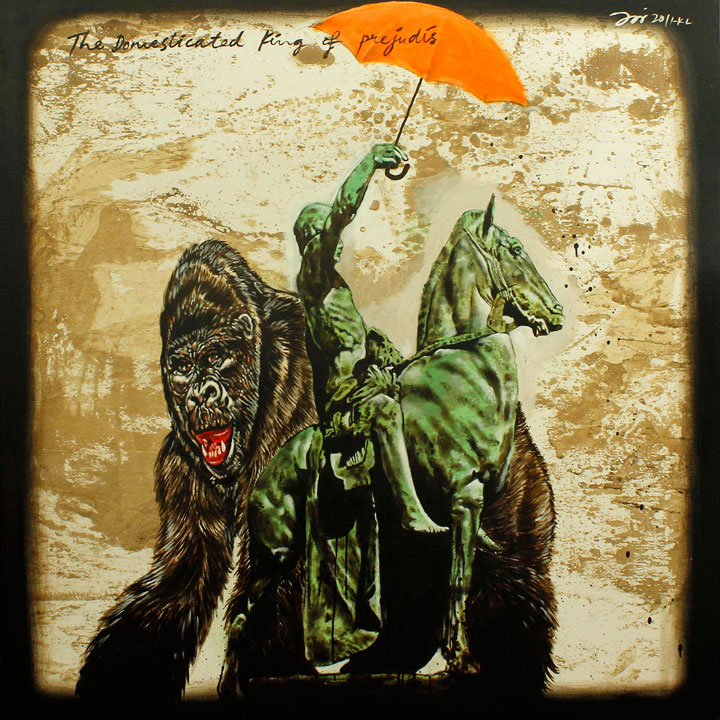Shows
Jalaini Abu Hassan’s “Bangsawan Kebangsaan”


Jalaini Abu Hassan’s new paintings at Tyler Rollins Fine Art play on the narrative techniques used in a form of proletarian Malay opera known as Bangsawan, which was popular from the 1920s to the 1960s. In the majority of the works presented, a wooden platform serves as a stage to ground his compositions, which are populated by figures derived from Bangsawan theater, such as the prince who stands haughtily upstage in The Blind Musician and the Angel (2011) and the Malay maiden and the healer (bomoh) in Bangsawan Melayu (2010).
Like Bangsawan, which developed out of a mixture of Malay, Indian, Islamic, Chinese, Indonesian and British influences, Hassan’s work encompasses a variety of references. He employs a lexicon of familiar forms, international icons and folkloric symbols to fashion a personal narrative in the likeness of an age-old story, which draws equally from day-to-day experience as from Malay politics.
Tengganu (Gincu Merah) (2011) is a portrait of Hassan’s daughter just as it is a juxtaposition of conservative Islamic religiosity and guileless indulgence. Likewise, Korban Kerbau Betina (2011) illustrates the instinctual aversion Hassan’s daughter felt when she witnessed the slaughter of a cow during Eid al-Adha, the ritual sacrifice celebrating the last day of the Haj Pilgrimage, but on a broader level also represents Muslim Malays’ ambiguous relationship to the consumption of beef.
Srikandi (2011) alludes to the tale of Srikandi, who is a powerful female figure in the Mahabharata. A woman in the forefront of this painting, assumedly Srikandi, dances before a bowl of rice. Behind her looms a rooster-masked man—a reference to bapak ayam, which is slang for “pimp.” Here, Hassan, touches on the sensitive issue of sex trafficking and the resultant despoliation of a Malaysian moral codes.
In Hassan’s most topical piece, The Domesticated King of Prejudis (2011), an aboriginal Australian man sits triumphantly on his steed, a facsimile of a statue that can be seen outside the Art Gallery of New South Wales. This image is laid over a depiction of King Kong, a mass culture icon from the period of Western modernist primitivism. The gorilla stands in resentful submission to an unseen subjugator, while the horse rider holds an umbrella up high in vain effort to preserve the pitiable indigenous people that King Kong ironically symbolizes. The artist is alluding to the questionable philosophy of the nationalist organization Perkasa, founded in 2008, ostensibly to defend the rights of indigenous Malays, who are seen as being persecuted by Malays of other ethnic origins within Malaysia, specifically the Chinese. Perkasa’s orthodox philosophy bears uncomfortable resemblance to ethnocentric supremacy. It is interesting that Hassan chose to portray an Australian minority to make this point—perhaps in an act of self-censorship to obscure his reference to the organization.

More personal than political, Tales of Heroes (2010) presents an intimate vignette of the artist’s family heritage, depicting the artist and his father in bomoh attire in the foreground of their kampung or Malay village house. In a number of his other paintings, Hassan assumes the role of his father and grandfather—who were both bomoh in real life—grounding his visual identity in Malay tradition. Self-conscious of his function as narrator, Hassan’s self-portrait stands slightly aloof and glances down toward his father, observing rather than participating in the scene.
“Bangsawan Kebangsaan” is an extension of Hassan’s continued fascination for the narrative possibilities of the art process. According to the artist, he is “exploring the mystery of the image, searching for its strength, seeing whether or not it can offer a story.” While undoubtedly Malaysian in theme, this exhibition differs from Hassan’s earlier endeavors in one significant aspect. Here, Hassan is aiming to appeal to a cosmopolitan audience, incorporating elements from global culture (King Kong is a global pop symbol, and the image of the blind musician, the prince, and the maiden play a part in many world cultures), seemingly in an effort to trigger a false sense of recognition through the power of iconography.







